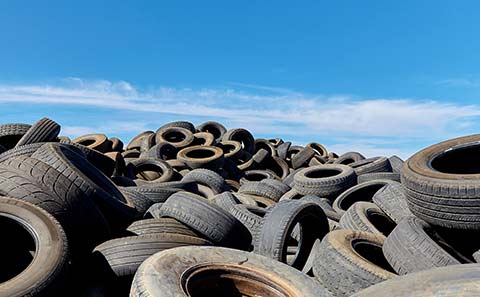For decades, most tires displayed a tread that was symmetrical across the tire: Both the inner and outer halves of the tread were identical or mirror images. Now, increasingly, tires have asymmetrical tread designs: The inner and outer halves of the tread have different patterns.
Why the change? What do asymmetrical tires do that symmetrical tires don’t? In theory, asymmetrical tires do more things well because the different tread elements are designed to do certain things better than the rest of the tread, and engineers place the tread components where they’ll do the most good.
How Does Symmetrical Tread Work?
Basically, the inner half of the tread is designed to master foul weather. It has channels and grooves to displace large amounts of water, slush and, on some all-season and winter tires, snow. The outer half of the tread is intended to supply extra stability and traction in both straight lines and corners.
For instance, Bridgestone says the chunkier tread pattern on the outside shoulder and outer half of the tread on its Turanza Serenity Plus enhance handling on dry roads. The inner shoulder and inner part of the tread have more channels and smaller blocks to disperse rain and slush, and to provide adequate traction in light snow.
You’ll see the same theory at work on a wide range of Pirelli asymmetrics, including high-performance P Zero tires, Run Flat lines and Scorpion Verde All Seasons. Goodyear employs asymmetric tread on several Eagle F1 performance tires.
Even mainstream touring tires, such as the Cooper CS5 Ultra, employ asymmetric tread styles quite effectively. The CS5 is durable, comfortable, good in light snow and rain, and quiet but sticky on dry pavement.
To make sure the tires are mounted properly, asymmetric tires have sides marked “inside,” “inboard” or “inner,” and “outside,” “outboard” or “outer,” or similar markings. Asymmetrical tires that are directional will also display an arrow in the direction of forward movement, visible on the outboard sidewall.
Rotating Asymmetrical Tires
It’s important to read the sidewall labels (the “small type”) to have the proper parts of the tread facing inside and outside. Usually, when an asymmetric tire is not directional, that means the tires can be moved front-to-back on the same side or opposite sides when rotating. That keeps the “outer” sidewall outside, regardless of axle position.
It’s different with an asymmetrical tire that’s also directional. Like other asymmetrical tires, the directional versions have a correct outboard sidewall. But unlike most asymmetric tires, the directional versions must be rotated same side, front-to-back, unless they are taken off the rims and remounted. Without remounting, they cannot be rotated to the opposite side of the vehicle or the weather-handling portion of the tread will run incorrectly on the inner shoulder, rather than the outer shoulder, and the handling-enhancing outer half of the tread will end up running backwards on the inner shoulder. Both dry-road and wet-weather performance would be negatively affected.
Future of Asymmetrics
Asymmetric tread will continue to make up more of consumer tires, especially in the replacement market but also increasingly in original equipment, according to industry observers.
Asymmetrics other than tread design also will come into play, according to Tire Review. Asymmetric compounds will allow one part of the tread to be stickier than others. And with asymmetric construction, tires will permit higher loads on the inboard sidewall—something that the Chevrolet Corvette already has offered.
What’s certain is that asymmetric design is here to stay—and to evolve.


